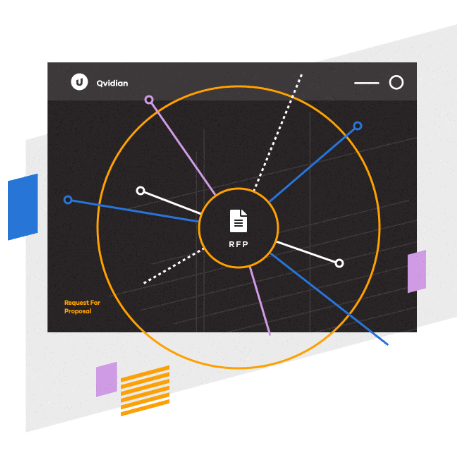RFP Response – How to Write a Winning Proposal
A request for proposal (RFP) response is a vendor’s answers to a set of questions posed by a prospective buyer. In a complex, competitive purchasing process, customers demand a compelling argument from vendors before they’re willing to sign off on what’s often a multi-year contract. Frequently, a committee (rather than an individual) makes the final call on which vendor to select after evaluating all accepted proposals.
Some organizations fall into the trap of believing that, if their sales team did its job, then a proposal is more or less a formality rather than a critical sales tool. But submitting an RFP response is about much more than getting a rubber-stamp from a client that already made up their mind.
Understand the Purpose of an RFP Response
It’s true that even a great proposal probably can’t revive a flagging deal, but a weak proposal can easily flush a strong deal right down the drain. Your commitment and attention to detail during the RFP response sets the stage for how you’ll treat your customer later.
If your prospect feels like they’re not valuable enough to warrant your careful consideration, they’ll happily go with the competitor that submitted a polished, customer-centric proposal instead.
Here’s seven steps from our experts to write a proposal that puts you on a firm footing to seal the deal.
RFP Response – 7 Tips To Writing a Winning Proposal
1. Qualify the Deal
The fastest way to improve your RFP response win rate is to stop bidding on opportunities you can’t win or are unlikely to win. It seems obvious, but organizations waste thousands of hours every year writing proposals for opportunities that never had a chance because they don’t have the confidence to walk away from mismatched opportunities.
Trying to close a deal is an investment, and you should treat it as such. If an RFP arrives in your inbox unannounced, for example, it’s doubtful you’ll end up winning the business. If you’re one of the rare few who have hours to spare, you may consider crafting a reply. But, more likely than not, you can’t afford to drop everything to go after long-shot deals.
There’s no shame in focusing on safer bets. In fact, it’s the strategic thing to do and your win rates—and your company—will thank you. Dedicate time to the opportunities you know a lot about, feel well-positioned to win, and that came from prospects who are serious about making a purchase decision.
If you’re in the fortunate situation of receiving more RFPs than you can keep up with, you can afford to be even pickier. Only reply to RFPs from prospects that fit well within your ideal customer profile (ICP). These prospects are most likely to derive the maximum value from your company for the lowest level of effort on your part, which typically leads to a higher customer lifetime value (CLV).
2. Focus on the Prospect’s Priorities
The fastest way to lose a prospect’s interest is to talk about yourself, and your RFP response’s executive summary sets the stage for your entire proposal. Instead of wasting time talking about your company, its products, and its history, use the precious real estate in your executive summary to zero-in on the challenges the prospect cares about solving and outline the ways your company will help solve them.
While it’s fine to get a jump start by starting from a prewritten executive summary, resist the urge to cut corners and submit generic boilerplate. Work with your starter executive summary content to tailor something specific to the opportunity in play. From paragraph one, prove to the prospect that you understand their pain points, and then lay out the benefits they’ll see by choosing to work with you. Winning proposals are customer-centric from cover to cover.
3. Structure Your Proposal Persuasively
The way you write RFP responses must be intentional. Proposals should proactively answer the critical questions prospects will have as they work through the stages of selecting a new vendor. Your prospect has a lot on the line and will be taking a risk no matter which company they select. Do your part to put their mind at ease and present your organization as the clearly superior solution.
To turn the theory into practice:
- Summarize the prospects’ unique needs. If they have several needs, consider focusing only on their top three, most time-sensitive and business-critical needs, so your message doesn’t get lost in a sea of other less important information.
- Example: I need to keep up with an ever-growing volume of RFPs.
- Recommend the solution that best addresses the prospect’s needs and goals. If your company only sells a single product or service, this step is simple. If you sell a wide portfolio of products and services, only suggest one or two that best address the prospect’s needs.
- Example: Upland Qvidian RFP response automation and proposal management software.
- Outline probable outcomes that make a purchase worth making. If the prospect walks away with the impression that it would be riskier to stick with the status quo than to take a chance by purchasing a new product or service, then you’ve succeeded in this section.
- Example: Create high-quality RFP responses quickly to answer more RFPs with the same resources and win more business.
- Provide evidence that your organization is the one for the job. Be sure to tailor the evidence you select to the opportunity. Only use generic facts, metrics, and proof points as a fallback.
- Example (for a security-conscious Financial Services company): Four of the five largest asset management firms and eight of the ten largest U.S. depend on Qvidian.
4. Differentiate Your Offer and Your Company
To avoid battling solely on price, make it clear how you add unique value that a prospect cannot find elsewhere. Usually, you shouldn’t be talking about features here, but rather benefits and outcomes.
Especially in a crowded market, consider highlighting your organization’s approach to its work and stance on customer success: What is your unique methodology? Your proven best practices? Your time-proven systems and processes?
5. Outline a Compelling Value Proposition
Your value proposition is the promise you make to your prospects that they will achieve more of the results they’re looking for if they partner with you. Shockingly, that simple promise is missing from most proposals.
Identify what specifically your prospect is after and tie your differentiators explicitly to that goal. Even seasoned professionals often slip up here, which means the odds are good that your competition won’t excel here. That makes the opportunity to stand out even greater if you dedicate the time to nail this section.
6. Make Your Proposal Easy to Understand
Complex B2B purchase decisions are already stressful and time-consuming. The last thing you want to do in your RFP response is make the prospect’s job harder. Refine and clarify your argument by removing jargon, unnecessary acronyms, and pretentious words. Slash your complex sentences so they’re easy to read, and cut out redundancies and filler.
Above all, make sure your final proposal is skimmable. Executive budget holders aren’t going to read every word, so you want your key points and most compelling arguments to jump off the page. Keep in mind: if everything is “important,” then nothing is important. Actively design your proposal to draw the reader’s eyes to the points you want them to remember most.
7. Edit Your Proposal, Then Edit It Again
Losing businesses over a careless mistake is painful. Ultimately, it doesn’t matter how persuasive your points are if your proposal is peppered with spelling, grammar, and formatting errors. Even careful editors may find their minds filling in the gaps and glazing over issues if they’re too close to the document.
Reading sections out loud or using a text-to-speech tool is a classic way to catch strange-sounding sections and subtly mistakes you might overlook overwise. If your time and resources allow, it’s ideal to get a second set of eyes on your proposal before sending it out the door. The bottom line is: don’t give your readers any excuse to discredit your carefully crafted arguments.

How Proposal Software Bolsters RFP Responses
Lastly, it’s important to consider the tools your team will need to help them optimize their RFP responses. Proposal automation software can help your team save time and increase their win rate.
When choosing the best proposal software for your team, it’s important to keep several key factors in mind, including how well it integrates with your current technology stack, how well it enables collaboration, and how well its features meet the needs of your team. Here are just some of the ways proposal software can improve your RFP responses.
Completing more proposals, faster than before
Proposal teams are often saddled with the ever-increasing expectation to respond to RFPs or produce more proactive proposals. This task can feel daunting for those without proposal automation. With proposal software, teams can finish proposals faster than before. Qvidian users report spending around 28% less time on each response, giving them more time to spend on other avenues of business.
Tools like a central content library and automatic content suggestion reduce the time team members spend searching for the appropriate content. With all content stored just a few clicks away, teams can generate full answers or responses in minutes, not hours.
Giving you features you need to get the job done
Having the right tools makes all the difference when crafting proposals. We’ve found that most teams without proposal software often struggle with streamlining their workflow. These teams jump from software to software as they work on a proposal, wasting valuable time and causing unnecessary bottlenecks in the response process.
Great proposal software gives you all the features your team needs to create winning proposals. Key features include workflows for review and approval, central content storage, user permissions, and advanced automation that makes responding easier. By packaging all your teams’ needs into a single software, you’ll streamline collaboration while saving time.
Helping your team answer questions in a unified voice
How many people currently work on each proposal you create? Chances are high that you’ve got at least 3 people working together to create content and finalize a proposal. Each member of your team is unique and often as team members divide and conquer a proposal, the final product will reflect these different voices.
Proposal software helps teams craft proposals with a unified voice. Team members can pull the content they need from a centralized library, ensuring that every piece of content is on brand. Additionally, each time a team finishes a proposal, they can store all answers needed in the library. As your library grows, team members have less of a need to craft new responses, limiting the possibility your contents’ voice veers off track.
Measuring your answers and promoting winning responses
For many proposal teams, once a response is finished, their work is done. However, by analyzing your content post-submission, you’ll gather key data on what works and what doesn’t.
When deciding on a RFP response software, make sure to invest in software with robust analytics. After submitting a response, you’ll want to track crucial data points like win-rates and which content performed best. Use this data the next time you craft a proposal to ensure you’re always promoting winning responses.
Final Thoughts on Writing a Winning RFP Response
Ultimately, a persuasive RFP response isn’t a bonus: it’s an essential part of the sales process. Your proposals should be the closing argument of a hard-fought, skillfully executed sale. By staying focused on the prospect and building a thoughtful, repeatable RFP response process, you’ll drive your win percentages up and maximize the efficiency of your limited resources.
